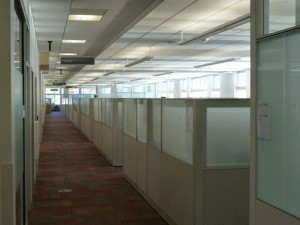Are we thinking about daylighting all wrong?
by Erik Missio | July 9, 2015 12:48 pm
 [1]
[1]by Michael J. Holtz, FAIA, NCARB, LEED AP
Daylighting is an integral part of architectural design. After all, building occupants want a physical and psychological connection to the outside world. We evolved under sunlight; our Circadian rhythms—governing daily living cycles, influencing our mood, and controlling our sleep patterns—developed in response to a connection to the outdoors. Unfortunately, how many design/construction professionals approach daylighting can be problematic.
Windows, skylights, and atria connect interior spaces with the exterior environment. These apertures also define and shape the architectural character of the building, and thus are important elements of architectural design. Throughout history, they have served multiple functions, from views and fresh air to emergency egress and even communication. After the oil embargo of the mid‐1970s, use of these apertures for their lighting-energy-saving potential—in other words, turning off or dimming electric lights when adequate daylight levels exist—has become an established strategy in new and existing commercial buildings. However, this has had some serious unintended consequences.
Many building owners and architects now view daylighting as they do other energy-saving design strategies, such as increased envelope insulation levels or more efficient HVAC and electric lighting systems. The inherent benefits of views, occupant well-being and health, improved productivity, and psychological connection to the outdoors are often forgotten or diminished. Instead, rigid energy-related cost-benefit analysis has taken their place.
Building owners and developers are now asking their architects, “What is the payback or return on investment (ROI) on integrating these daylighting strategies and daylight-responsive electric lighting controls into my building?” This ROI calculation can only consider the energy savings achieved by turning off electric lights, however; it cannot include any of the occupant productivity, well-being, and health-related benefits. With such a rigid definition of ROI, it is nearly impossible to achieve a satisfactory economic payback.
This whole matter has been compounded by the widespread introduction of light-emitting diodes (LEDs). When incandescent and fluorescent lighting technology dominated the commercial building market, significant energy savings were achievable by turning off or dimming electric lighting during daytime hours. A 1 to 2 Watt per square foot lighting power density with incandescent or fluorescent lighting meant a 50 percent lighting energy reduction generated significant cost savings. However, with LED lighting moving to a 0.4 to 0.5 W/sf lighting power density, this same energy reduction generates little in cost savings.
Consequently, daylighting is no longer considered a ‘viable’ energy-saving design strategy for some because it does not pencil out from a simple payback or ROI point of view. Since many design professionals have bought into this way of thinking and have become hostage to it, they have lost the ability to forcefully argue against this narrow energy economic view of daylighting.
If architects care about improved occupant comfort, health, and productivity, and about achieving significant energy savings, then aggressive daylighting is an essential design strategy. However, it must be an integral part of all their designs, just like indoor plumbing, and not subject to the vagaries of ROI calculations and simplistic energy economics. Architects make thousands of decisions and trade‐offs during the course of designing a building; ensuring the inclusion of aggressive daylighting into their designs is easily accomplished when it is a high priority, particularly if an integrated design process (IDP) approach is used.
 [2]
[2]Current marketplace economics do not properly value all the benefits of daylighting—rather, it demands meeting narrowly defined energy economic criteria before being considered and incorporated into buildings. Daylighting must become a mandatory requirement in building codes and standards, such as American Society of Heating, Refrigerating, and Air-conditioning Engineers (ASHRAE) 189.1, Standard for the Design of High-Performance Green Buildings, and the International Green Construction Code (IgCC).
The requirements must address both quantitative (illumination levels) and qualitative (glare) issues in the daylit zones, and do so in a performance‐based approach. Currently, most daylighting code requirements, such as California’s Title 24, address only electric lighting controls (i.e. require daylight harvesting controls ) in the perimeter zones of buildings, and do not deal with occupant visual comfort like glare or high contrast ratios.
Architects must become better educated in understanding and applying daylighting design principles. In an ideal world, more design professionals would be forceful and effective in advocating for daylighting with their clients. Simply put, they should not condone or participate in the misdirected conversations regarding daylighting economics, unless all the energy and non‐energy benefits of daylighting are allowed to be included in this economic analysis.
 [3]Michael J. Holtz, FAIA, NCARB, FASES, LEED AP, is an architect and a co-founder of LightLouver LLC, located in Louisville, Colorado. Previously, he was president and CEO of Architectural Energy Corporation, chief of the building systems research branch of the Solar Energy Research Institute (now known as National Renewable Energy Laboratory [NREL]), and a research scientist at the National Bureau of Standards (now National Institute for Standards and Technology [NIST]). Holtz is currently leading an effort to develop a daylighting code for ASHRAE 189.1. He can be reached via e-mail at mholtz@lightlouver.com[4].
[3]Michael J. Holtz, FAIA, NCARB, FASES, LEED AP, is an architect and a co-founder of LightLouver LLC, located in Louisville, Colorado. Previously, he was president and CEO of Architectural Energy Corporation, chief of the building systems research branch of the Solar Energy Research Institute (now known as National Renewable Energy Laboratory [NREL]), and a research scientist at the National Bureau of Standards (now National Institute for Standards and Technology [NIST]). Holtz is currently leading an effort to develop a daylighting code for ASHRAE 189.1. He can be reached via e-mail at mholtz@lightlouver.com[4].
- [Image]: http://www.constructionspecifier.com/wp-content/uploads/2015/07/1-Manassas-Park-Classroom0064_kittner_090813_hdr.jpg
- [Image]: http://www.constructionspecifier.com/wp-content/uploads/2015/07/5-Suncor-Interior-81_.jpg
- [Image]: http://www.constructionspecifier.com/wp-content/uploads/2015/07/Michael-Holtz.jpg
- mholtz@lightlouver.com: mailto:mholtz@lightlouver.com
Source URL: https://www.constructionspecifier.com/are-we-thinking-about-daylighting-all-wrong/